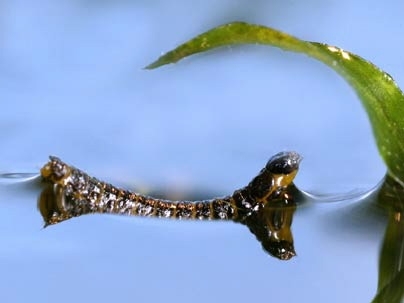MIT mathematicians have discovered how certain insects can climb what to them are steep, slippery slopes in the water's surface without moving their limbs--and do it at high speed.
Welcome to the world of the tiny creatures that live on the surface of ponds, lakes and other standing bodies of water. There, "all the rules change," said David Hu, a graduate student in the Department of Mathematics and first author of a paper on the work to appear in the Sept. 29 issue of Nature.
For the last four years, Hu and John Bush, an associate professor in the department, have been studying the novel strategies these insects use to navigate their environment. To do so, they took high-speed video of the creatures using a camera provided by MIT's Edgerton Center, then digitized and analyzed the images.
In 2003, the two and Brian Chan, a graduate student in the Department of Mechanical Engineering, reported in Nature how some of these creatures walk on water. Both that paper and the current one were Nature cover stories.
Now Bush and Hu are describing how three species of insects are able to climb the slippery slopes, or menisci, that arise when the water surface meets land, floating bodies or emergent vegetation.
Why would they want to leave the water? "There are many reasons, such as laying eggs or escaping predators," said Hu.
Menisci are all around us--picture the slight upward curve of water in a glass where it meets the side. "But we don't notice them because they're so small, only a few millimeters in height," said Hu. But if you're a creature that's much smaller than that, those slopes "are like frictionless mountains," Hu said. "Plus, it's slippery."
In these conditions, the insects' normal modes of propulsion won't work. Hu and Bush took high-speed video of insects trying to ascend menisci with a running start and found they got partway up, then slid back down.
The solution? The creatures adopt special postures that create forces that pull them up the slope at speeds of almost 30 body lengths per second (for comparison, an Olympian sprinter moves at about five body lengths per second).
For example, Hu and Bush found that two species of water treaders have retractable claws on their front and hind legs that allow them to "grasp" the surface of the water and pull it into a miniscule peak. The insect simultaneously presses down on the water with its central pair of legs, forming dimples in the water surface that bear the creature's weight.
Because the insects are so small, these perturbations create forces that suck them up the slope, similar to the way champagne bubbles rise to the edge of a glass.
Bush explains that the insect is actually "generating tiny menisci" with its front and hind legs. Since menisci are attracted to other menisci, the cumulative effect is to pull the insect up and over the meniscus at the water's edge.
Remember the champagne bubbles? Each essentially forms its own meniscus, hence the attraction to the edge of the glass.
The larva of the waterlily leaf beetle solves the same problem a different way. The sluglike creature simply arches its back, creating menisci at each end. The effect has the same end result, propelling the larva up the slope.
Bush and Hu got involved in this work because they wanted to explain how these creatures do what they do. Bush notes, however, that "the physics is also of interest to people working in nanotechnology because they, too, are concerned with problems at very small length scales."
Hu will be defending his thesis on Sept. 28.
This work was sponsored by the National Science Foundation.
A version of this article appeared in MIT Tech Talk on October 5, 2005 (download PDF).






